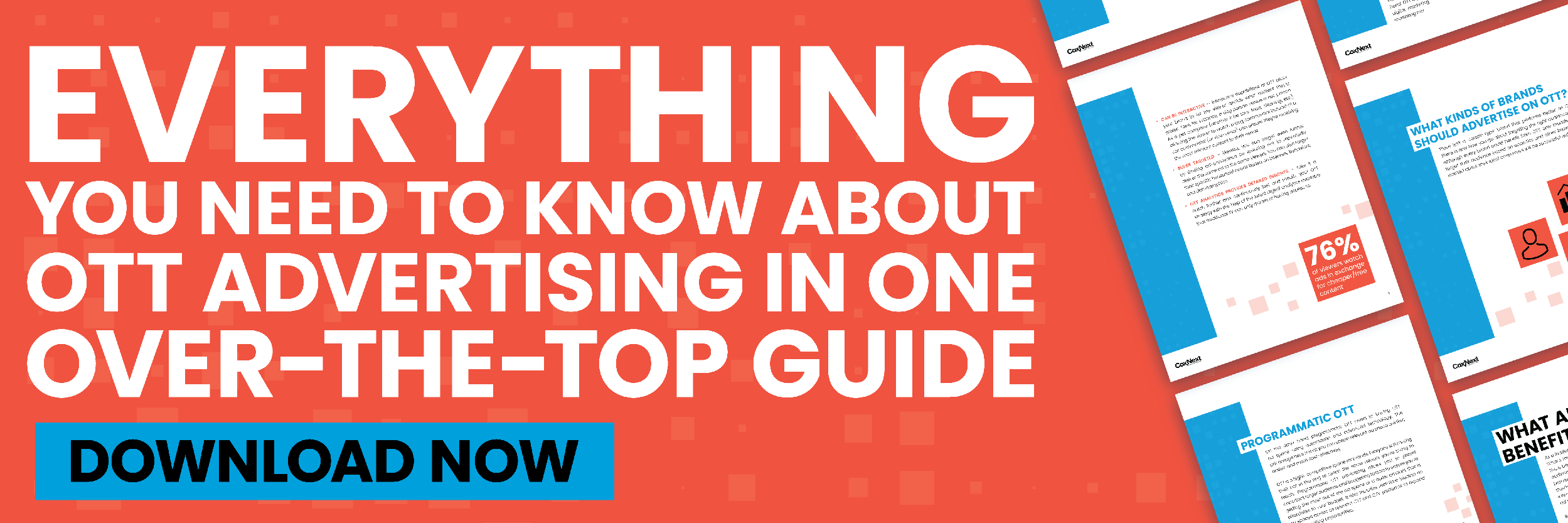How to Get Started with OTT and Streaming

Over the last several years, OTT and streaming services have become increasingly popular, both for viewers and advertisers looking to get more ROI out of their marketing. OTT, or "over-the-top television”, are streaming services offered to users directly through the internet. Seventy-four percent of U.S. households have access to at least one streaming service, and the average U.S. household subscribes to around three different services. These numbers continue to rise as more channels and providers create their own specific services.
These OTT services allow viewers a great deal more control over what they're watching and when. Instead of having to tune in at a specific time to catch the programming they want to see, viewers have the ability to choose exactly what they want to watch at any time. Your brand can take advantage of streaming and OTT services to get your content in front of a more specific target audience and here are some tips on how to get started:
Identify Your Audience
Before you get started, you need to know exactly who your audience is. You want to know where they are geographically, when they're likely to log on, as well as their viewing and buying habits. Do your customers prefer a specific type of programming? Do they tend to watch at a specific time of day? Data-driven ads can create between 5 and 8 times greater return on your marketing investment. The more you know about your target audience, the better you can tailor your ads, increasing the odds that you will fully connect with them.
Select a Media Partner
Once you have a clear understanding of your target audience, you can use that understanding to choose a media partner. Ideally, you want to work with a media partner that has access to your target audience. One that can help get your ads in front of consumers who are most likely to be interested in your services will be more beneficial to your business in the long run. When you look for a media partner, evaluate whether they can help you with creating, delivering, and analyzing your OTT creative. This will help you put out high-quality content designed with your target audience in mind.
Working with a media partner can help ensure that you're creating the right content at the right time, as well as analyzing the effectiveness of your ads. Transparency and detailed reporting with OTT is also key. A good media partner will optimize your existing campaign and ensure that it has the features it needs to help you meet your goals, rather than using the makegood or preemption model, in which you end up altering your campaign after the fact.
Decide on Your CTA
A proper call-to-action is important for successful OTT content. Interactive CTAs help OTT stand out. Viewers can often click directly on the ad to take action, allowing them to take an immediate next step. By providing interactive CTAs, you are giving the viewer an opportunity to act now, rather than relying on them to take that suggested action later.
CTV or connected devices are a huge percentage of those used to watch OTT content--which means they are not necessarily clickable.However, two out of every three people use a second screen to look up information about a product they saw while watching a program. Video completion rate is often also higher for connected TVs.
Determine Your Platforms
Your target audience likely uses a number of different platforms, including Netflix, Amazon Prime, Hulu, Apple TV, and Roku. It seems as though new streaming services are popping up everywhere. For many businesses, however, it's much more effective to focus on a small number of platforms. This strategy can allow you to create higher-quality ads designed exactly for the audience on those platforms. A media partner can help you determine what's best for your business, including the ideal platform to reach your target audience and the strategies you need to use on a specific platform.
Produce Your Creative
When you're working with a one-stop-shop media partner, they can help you from start to finish as you produce your creative and determine your strategy. This takes the pressure off your business. Often, you can repurpose old creative, which will allow you to save ad dollars while deploying OTT content quicker. All creative, however, needs to be optimized for a specific platform in order to create the most effective results. Each platform is different, has unique needs and requirements, making it very important that each piece of content is created and optimized with the platform in mind.
OTT and streaming ads can help significantly increase your reach and allow you to better target your preferred audience so that you can deliver high-quality ads that speak specifically to your ideal consumer. By working with a trusted digital partner, you can move through the creative process more easily and ensure that you have the tools on hand to design and create the creative material you need to succeed with OTT.
Related Posts
What is the Future of TV Advertising?
March 22nd, 2023How to Evaluate the Effectiveness of Your Ads
August 10th, 2022How to Effectively Advertise to Cord Cutters
August 3rd, 20225 Insider Advertising Tips for the Rest of 2022
May 18th, 2022What is Programmatic OTT Advertising and Why is it Important?
April 27th, 2022Categories
- Marketing Strategy (90)
- Digital Advertising (47)
- Digital Marketing (28)
- Content Marketing (17)
- OTT (16)
- ROI (13)
- Content Creative (12)
- Agency Partnerships (11)
- Social (10)
- Video (8)
- COVID-19 (7)
- Advanced Data (6)
- Research (6)
- Technology (6)
- Cox Enterprises News (5)
- Generational Marketing (5)
- Industry: Travel (5)
- Industry: eCommerce (5)
- Advertising Budget (4)
- Industry: Higher Education (4)
- Social Media Marketing (4)
- E-commerce (3)
- Podcasts (3)
- Recruitment Marketing (3)
- Search (3)
- Social Media (3)
- Branding (2)
- Inclusive Marketing (2)
- Industry: Cannabis (2)
- Industry: Home Improvement (2)
- marketing budget (2)
- CoxNext News (1)
- Industry - Automotive (1)
- Industry: Healthcare (1)
- Influencer Marketing (1)
- Podcast Advertising (1)
- Privacy (1)
- working with an agency (1)



.jpg)

.jpg)






